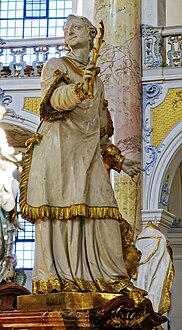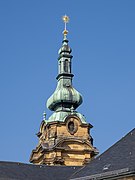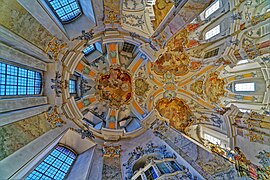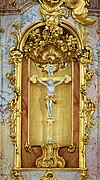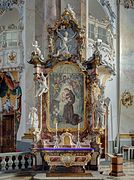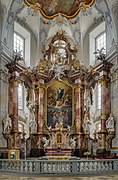|
Basilica of the Fourteen Holy Helpers
The Basilica of the Fourteen Holy Helpers (German: Basilika Vierzehnheiligen) is a church located near the town of Bad Staffelstein near Bamberg, in Bavaria, southern Germany. The late Baroque (Rococo) basilica, designed by Balthasar Neumann, was constructed between 1743 and 1772. It is dedicated to the Fourteen Holy Helpers, a group of saints venerated together in the Catholic Church, especially in Germany at the time of the Black Death. The interior has been nicknamed "God's Ballroom".[1] Location The Basilica overlooks the river Main in Franconia. It sits on a hillside, and on the hillside opposite is Schloss Banz, a former Baroque abbey. Together they are known as the Goldene Pforte or golden portal, an entryway to the historic Franconian towns of Coburg, Kronach, Kulmbach, and Bayreuth. LegendOn 24 September 1445, a young shepherd Hermann Leicht saw a crying child in a field near a Cistercian monastery in Langheim. As he bent down to pick up the child, it abruptly disappeared. A short time later, the child reappeared in the same spot along with two floating candles and Hermann reported it to the Cistercians. The next summer, he saw the child a third time. This time, the child bore a red cross on its chest and was accompanied by fourteen other figures. The child said they were the fourteen helpers and would help others if a chapel was erected for them. The two candles descended and the vision disappeared, after which the healing miracles began.[2][3] 18 days after the third apparition, a fatally ill maid from Langheim was cured after she invoked the help of the Fourteen Holy Helpers. Langheim abbey, which had been previously skeptical concerning the apparitions, recognized them and a pilgrimage was soon begun.[1]   The Cistercian brothers to whom the land belonged erected a chapel, which immediately attracted pilgrims. An altar was consecrated as early as 1448. Pilgrimages to the Vierzehnheiligen continue to the present day between May and October. ConstructionThe present church was built from 1743 to 1772. Its unique interior, in the style of Rococo, is due to an irregularity in the construction. Langheim Abbey wished for the costs of construction to be lowered and thus changed the architectural plans, despite the foundational stone already being laid. When this was discovered by Neumann, the architect, the walls of the three apses had already been erected. The Altar of Grace (which being the site of the apparitions could not be moved) would no longer be located in the center of the crossing as originally intended but in the nave. Neumann thus split the room into three ovals and placed the Altar back in the center by making it the center of the largest oval rotund in the middle, surrounded by four columns on each side.[1] The Mercy Altar of the VierzehnheiligenThe Mercy Altar, also known as the Gnadenaltar, marks the site where the apparition of the Fourteen Holy Helpers occurred. The fourteen statues adorning the altar are: 
The High Altar of Vierzehnheiligen The central scene of the unobstructed and towering high altar is a larger-than-life painting showing the Assumption of the Blessed Virgin Mary. The statues depict her spouse Joseph, her father Joachim, and David and Zachariah. PulpitFree-floating white putti bear the pulpit, ornamented with the golden reliefs of the Evangelists which are surrounded by shellwork. The pulpit tester (sound board) is made of rays in a spherical shape. Gallery
See alsoReferencesCitations
Sources
External linksWikimedia Commons has media related to Basilika Vierzehnheiligen. |
||||||||||||||||||||||||||||



